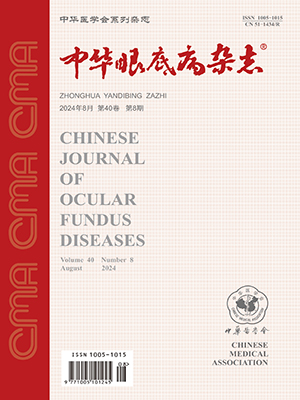| 1. |
Yannuzzi LA, Wong DW, Sforzolini BS, et al. Polypoidal choroidal vasculopathy and neovascularized age-related macular degeneration[J]. Arch Ophthalmol, 1999, 117:1503-1510.
|
| 2. |
Koh A, Lee WK, Chen LJ, et al. EVEREST study: efficacy and safety of verteporfin photodynamic therapy in combination with ranibizumab or alone versus ranibizumab monotherapy in patients with symptomatic macular polypoidal choroidal vasculopathy [J].Retina,2012,32:1453-1464.
|
| 3. |
Sho K, Takahashi K, Yamada H, et al. Polypoidal choroidal vasculopathy: incidence, demographic features, and clinical characteristics[J]. Arch Ophthalmol, 2003,121:1392-1396.
|
| 4. |
Uyama M, Wada M, Nagai Y, et al. Polypoidal choroidal vasculopathy: natural history[J]. Am J Ophthalmol,2002,133:639-648.
|
| 5. |
Hirami Y, Mandai M, Takahashi M, et al. Association of clinical characteristics with disease subtypes, initial visual acuity, and visual prognosis in neovascular age-related macular degeneration[J]. Jpn J Ophthalmol, 2009, 53:396-407.
|
| 6. |
Bessho H, Honda S, Imai H, et al. Natural course and funduscopic findings of polypoidal choroidal vasculopathy in a Japanese population over 1 year of follow-up [J]. Retina,2011,31:1598-1602.
|
| 7. |
Yuzawa M. Polypoidal choroidal vasculopathy[J]. Nippon Ganka Gakkai zasshi, 2012,116:200-231.
|
| 8. |
Iida T.Diagnostic criteria for polypoidal choroidal vasculopathy and their clinical significance[J]. Nihon Ganka Gakkai Zasshi,2005,109:383-384.
|
| 9. |
Gomi F, Ohji M, Sayanagi K,et al. One-year outcomes of photodynamic therapy in age-related macular degeneration and polypoidal choroidal vasculopathy in Japanese patients[J].Ophthalmology,2008,115:141-146.
|
| 10. |
Lai TY, Chan WM, Liu DT,et al. Intravitreal bevacizumab (Avastin) with or without photodynamic therapy for the treatment of polypoidal choroidal vasculopathy[J]. Br J Ophthalmol,2008,92:661-666.
|
| 11. |
Koizumi H, Yamagishi T, Yamazaki T,et al. Subfoveal choroidal thickness in typical age-related macular degeneration and polypoidal choroidal vasculopathy[J]. Graefe's Arch Clin Exp Ophthalmol, 2011,249:1123-1128.
|
| 12. |
刘冉, 李加青, 李涛, 等. 息肉样脉络膜血管病变的频域光相干断层扫描图像特征分析[J]. 中山大学学报(医学科学版), 2012, 33:841-847.
|
| 13. |
Maruko I, Iida T, Saito M,et al. Clinical characteristics of exudative age-related macular degeneration in Japanese patients[J]. Am J Ophthalmol, 2007, 144:15-22.
|
| 14. |
Miki A, Honda S, Kojima H,et al. Visual outcome of photodynamic therapy for typical neovascular age-related macular degeneration and polypoidal choroidal vasculopathy over 5 years of follow-up[J]. Jpn J Ophthalmol, 2013:57:301-307.
|
| 15. |
Kokame GT, Yeung L, Lai JC. Continuous anti-VEGF treatment with ranibizumab for polypoidal choroidal vasculopathy: 6-month results[J]. Br J Ophthalmol,2010,94: 297-301.
|
| 16. |
Mathew R, Richardson M, Sivaprasad S. Predictive value of spectral-domain optical coherence tomography features in assessment of visual prognosis in eyes with neovascular age-related macular degeneration treated with ranibizumab[J]. Am J Ophthalmol, 2013, 155:720-726.
|
| 17. |
Chung SE, Kang SW, Lee JH,et al. Choroidal thickness in polypoidal choroidal vasculopathy and exudative age-related macular degeneration[J]. Ophthalmology, 2011,118:840-845.
|




